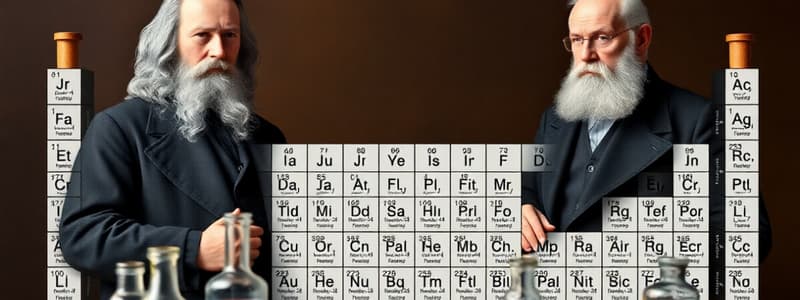Podcast
Questions and Answers
Who is known for organizing the first version of the periodic table?
Who is known for organizing the first version of the periodic table?
- Marie Curie
- John Dalton (correct)
- Isaac Newton
- Dimitri Mendeleev
Dimitri Mendeleev ordered the elements according to their atomic number.
Dimitri Mendeleev ordered the elements according to their atomic number.
False (B)
What significant prediction did Dimitri Mendeleev make regarding elements in the periodic table?
What significant prediction did Dimitri Mendeleev make regarding elements in the periodic table?
He predicted the exact weight and reactivity of elements that would fall into gaps in his table.
John Dalton discovered that all elements had a different __________ weight.
John Dalton discovered that all elements had a different __________ weight.
Match the following scientists with their contributions to the periodic table:
Match the following scientists with their contributions to the periodic table:
What does the atomic number of an element represent?
What does the atomic number of an element represent?
The atomic mass is determined solely by the number of protons.
The atomic mass is determined solely by the number of protons.
How does the number of outer shell electrons relate to the reactivity of an element?
How does the number of outer shell electrons relate to the reactivity of an element?
The number of ______ determines the number of periods when analyzing an element in the periodic table.
The number of ______ determines the number of periods when analyzing an element in the periodic table.
Match the following terms with their definitions:
Match the following terms with their definitions:
What is the primary factor by which the elements in the periodic table are ordered?
What is the primary factor by which the elements in the periodic table are ordered?
Groups in the periodic table refer to the rows that go across.
Groups in the periodic table refer to the rows that go across.
What are the two main ways the periodic table is organized?
What are the two main ways the periodic table is organized?
State the two discoveries made by John Dalton in regard to the periodic table.
State the two discoveries made by John Dalton in regard to the periodic table.
John Dalton ordered elements together by their ____ ___.
John Dalton ordered elements together by their ____ ___.
Mendeleev was the first to group elements together.
Mendeleev was the first to group elements together.
What did Mendeleev do in regards to the periodic table? (3 marks)
What did Mendeleev do in regards to the periodic table? (3 marks)
State the difference between how we order the elements in the periodic table today in comparison to how Dalton and Mendeleev ordered it.
State the difference between how we order the elements in the periodic table today in comparison to how Dalton and Mendeleev ordered it.
Flashcards
Dalton's Atomic Theory
Dalton's Atomic Theory
John Dalton discovered that all elements are made up of only one type of atom.
Grouping Elements by Atomic Weight
Grouping Elements by Atomic Weight
John Dalton grouped elements based on their atomic weight, which is the mass of an atom of that element.
Mendeleev's Periodic Table
Mendeleev's Periodic Table
Dmitri Mendeleev created the periodic table by arranging elements in order of increasing atomic weight, leaving gaps for undiscovered elements.
Predictive Power of Mendeleev's Table
Predictive Power of Mendeleev's Table
Signup and view all the flashcards
Modern Periodic Table - Atomic Number
Modern Periodic Table - Atomic Number
Signup and view all the flashcards
What is the relationship between group number and atom structure?
What is the relationship between group number and atom structure?
Signup and view all the flashcards
What is atomic mass?
What is atomic mass?
Signup and view all the flashcards
What is the atomic number?
What is the atomic number?
Signup and view all the flashcards
How does the number of shells relate to the period?
How does the number of shells relate to the period?
Signup and view all the flashcards
What does the number of shells indicate?
What does the number of shells indicate?
Signup and view all the flashcards
How is the number of electron shells related to the period?
How is the number of electron shells related to the period?
Signup and view all the flashcards
What are groups on the periodic table?
What are groups on the periodic table?
Signup and view all the flashcards
What are periods on the periodic table?
What are periods on the periodic table?
Signup and view all the flashcards
How is the periodic table organized?
How is the periodic table organized?
Signup and view all the flashcards
Study Notes
John Dalton's Contributions
- First to group elements together
- Discovered elements are made of one type of atom
- Discovered elements have different atomic weights
- Grouped elements together based on atomic weight
- Created the first periodic table
Dmitri Mendeleev's Contributions
- Looked for trends and patterns in elements
- Ordered elements by atomic weight
- Created a periodic table with gaps
- Predicted properties of undiscovered elements
- Recognized that elements should be ordered by atomic number, rather than atomic weight, as seen in the modern table.
- Noted that patterns in elements' weight and reactivity allowed him to predict the properties of missing elements and leave gaps if necessary.
- Noted trends to predict gaps in the table which allowed him to predict the exact properties of new elements.
Studying That Suits You
Use AI to generate personalized quizzes and flashcards to suit your learning preferences.
Description
Explore the key contributions of John Dalton and Dmitri Mendeleev to the development of the periodic table. This quiz covers their discoveries about atomic structure, atomic weights, and the ordering of elements that laid the groundwork for modern chemistry. Test your knowledge of these pivotal figures in science!




